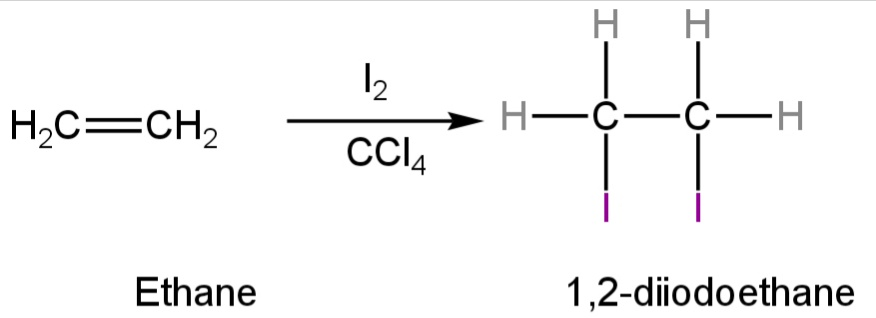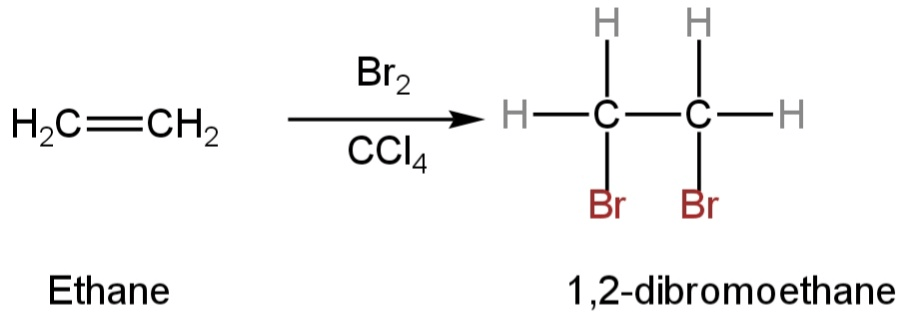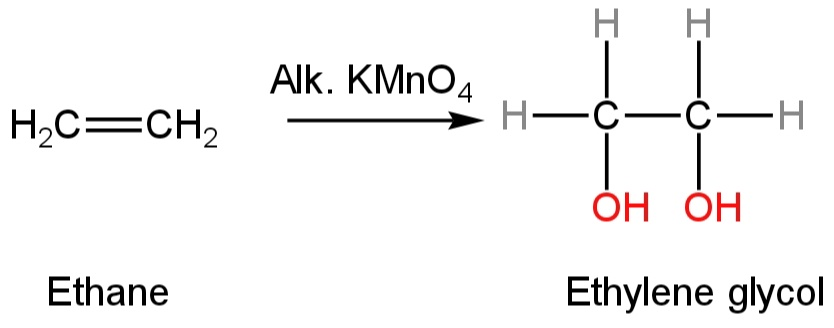
Which of the following is not used to distinguish ethene from ethane
A. Iodine in \[CC{{l}_{4}}\]
B. Bromine in \[CC{{l}_{4}}\]
C. Alkaline \[KMn{{O}_{4}}\]
D. Ammoniacal \[C{{u}_{2}}C{{l}_{2}}\]
Answer
219.9k+ views
Hint: Ethane is an organic chemical compound with the molecular formula \[{C_2}{H_6}\]. It is a saturated compound as it contains single bonds only. Ethene on the other hand has the molecular formula \[{C_2}{H_4}\]. It is an unsaturated compound. Ethane can be distinguished from ethene based on the different types of bonds present in them.
Complete Step by Step Answer:
Here in this question, we have to find out which one of the given options is not used to distinguish ethene from ethane.
A. Iodine in\[CC{l_4}\]
This reagent is helpful in the iodination of ethene.
Ethene when reacted with iodine in carbon tetrachloride forms 1,2-diiodoethane.
Iodine loses its violet colour and gives a colourless liquid due to the formation of 1,2-diiodoethane.

Image: Reaction of ethene with Iodine in\[CC{l_4}\]
This is an addition reaction.
Ethane doesn't react with iodine in the presence of carbon tetrachloride.
So, this reaction can be used to distinguish between ethene and ethane.
So, A is incorrect.
B. Bromine in \[CC{l_4}\]
This is also an addition reaction.
Ethene when reacted with bromine in carbon tetrachloride forms 1,2-dibromoethane.
The double bond breaks and a bromine atom is connected to each carbon.
The bromine loses its original red-brown colour and gives a colourless liquid.

Image: Reaction of ethene with Bromine in \[CC{l_4}\].
Ethane doesn't react with bromine in the presence of carbon tetrachloride.
So, this reaction can be used to distinguish between ethene and ethane.
So, B is incorrect.
C. Alkaline\[KMn{O_4}\]
Potassium permanganate is an oxidising agent.
Due to the presence of unsaturation in ethene, it gets oxidised into ethane-1,2-diol or ethylene glycol.
The reaction is given as follows:

Image: Reaction of Alkaline\[KMn{O_4}\] with ethene.
The pink colour of the potassium permanganate is discharged and a brown-colored precipitate of manganese dioxide is observed.
Ethane doesn't react with potassium permanganate.
So, this reaction can be used as a test for unsaturation called Baeyer’s test.
So, C is incorrect.
D. Ammoniacal \[C{u_2}C{l_2}\]
It is used to distinguish terminal alkynes.
In this reaction, a terminal alkyne when reacted with basic cupric chloride and on successive oxidation in the air produces diyne. For instance, two molecules of ethyne react to produce but-1,3-yne which is a red-brown precipitate. This reaction is not used as a test for ethene or ethane.
So, D is correct.
So, option D is correct.
Note: In terminal alkynes the triple bonds are present on the ends of the compound.
Ammoniacal cuprous chloride is made by dissolving cuprous chloride in water and ammonia forming a blue-colored solution.
Complete Step by Step Answer:
Here in this question, we have to find out which one of the given options is not used to distinguish ethene from ethane.
A. Iodine in\[CC{l_4}\]
This reagent is helpful in the iodination of ethene.
Ethene when reacted with iodine in carbon tetrachloride forms 1,2-diiodoethane.
Iodine loses its violet colour and gives a colourless liquid due to the formation of 1,2-diiodoethane.

Image: Reaction of ethene with Iodine in\[CC{l_4}\]
This is an addition reaction.
Ethane doesn't react with iodine in the presence of carbon tetrachloride.
So, this reaction can be used to distinguish between ethene and ethane.
So, A is incorrect.
B. Bromine in \[CC{l_4}\]
This is also an addition reaction.
Ethene when reacted with bromine in carbon tetrachloride forms 1,2-dibromoethane.
The double bond breaks and a bromine atom is connected to each carbon.
The bromine loses its original red-brown colour and gives a colourless liquid.

Image: Reaction of ethene with Bromine in \[CC{l_4}\].
Ethane doesn't react with bromine in the presence of carbon tetrachloride.
So, this reaction can be used to distinguish between ethene and ethane.
So, B is incorrect.
C. Alkaline\[KMn{O_4}\]
Potassium permanganate is an oxidising agent.
Due to the presence of unsaturation in ethene, it gets oxidised into ethane-1,2-diol or ethylene glycol.
The reaction is given as follows:

Image: Reaction of Alkaline\[KMn{O_4}\] with ethene.
The pink colour of the potassium permanganate is discharged and a brown-colored precipitate of manganese dioxide is observed.
Ethane doesn't react with potassium permanganate.
So, this reaction can be used as a test for unsaturation called Baeyer’s test.
So, C is incorrect.
D. Ammoniacal \[C{u_2}C{l_2}\]
It is used to distinguish terminal alkynes.
In this reaction, a terminal alkyne when reacted with basic cupric chloride and on successive oxidation in the air produces diyne. For instance, two molecules of ethyne react to produce but-1,3-yne which is a red-brown precipitate. This reaction is not used as a test for ethene or ethane.
So, D is correct.
So, option D is correct.
Note: In terminal alkynes the triple bonds are present on the ends of the compound.
Ammoniacal cuprous chloride is made by dissolving cuprous chloride in water and ammonia forming a blue-colored solution.
Recently Updated Pages
Difference Between Alcohol and Phenol: Structure, Tests & Uses

Class 12 Chemistry Mock Test Series for JEE Main – Free Online Practice

Electricity and Magnetism Explained: Key Concepts & Applications

JEE Energetics Important Concepts and Tips for Exam Preparation

JEE Isolation, Preparation and Properties of Non-metals Important Concepts and Tips for Exam Preparation

JEE Main 2021 July 25 Shift 1 Question Paper with Answer Key

Trending doubts
JEE Main 2026: Application Form Open, Exam Dates, Syllabus, Eligibility & Question Papers

Derivation of Equation of Trajectory Explained for Students

Hybridisation in Chemistry – Concept, Types & Applications

Understanding the Angle of Deviation in a Prism

How to Convert a Galvanometer into an Ammeter or Voltmeter

Understanding Centrifugal Force in Physics

Other Pages
Solutions Class 12 Chemistry Chapter 1 CBSE Notes - 2025-26

NCERT Solutions For Class 12 Chemistry Chapter 1 Solutions - 2025-26

The D and F Block Elements Class 12 Chemistry Chapter 4 CBSE Notes - 2025-26

NCERT Solutions for Class 12 Chemistry Chapter Chapter 7 Alcohol Phenol and Ether

NCERT Solutions ForClass 12 Chemistry Chapter Chapter 8 Aldehydes Ketones And Carboxylic Acids

JEE Advanced Marks vs Ranks 2025: Understanding Category-wise Qualifying Marks and Previous Year Cut-offs




